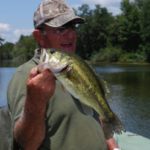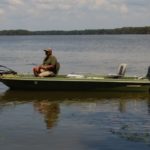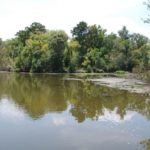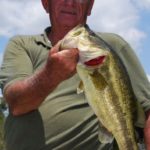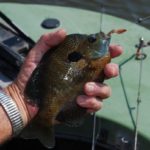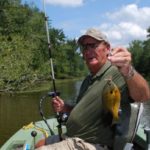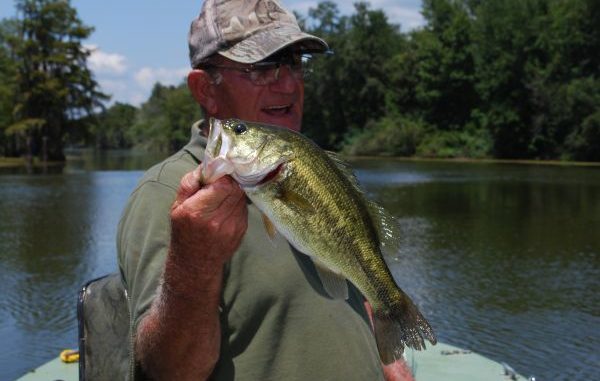
This long-time Atchafalaya Basin angler has found a new home on the fish-rich stretches of water between Bayou Corne and Lake Verret.
The craggy man at the bow controls of the boat turned off the boat’s engine. He lit a cigarette and scanned the points formed by the intersection of the Texaco Canal and Grand Bayou.
“I hung a big one here a couple of weeks ago,” he said matter-of-factly, in a twang that still showed some of his Arkansas roots.
The plume of blue cigarette smoke rose lazily in the air and mingled with the fertile smell of life enveloping us from the surrounding gorgeous swamp. The mixture of the two aromas was almost compellingly pleasant.
It’s hard to believe that less than a half hour ago I descended from the Sunshine Bridge into civilization — strip malls, convenience stores, housing developments and sprawling petrochemical plants. But Highway 70 quickly took me away from the high ground along the Mississippi River into a vast swamp full of gros-bec cypress spiced by majestic old snags left behind by choosy lumbermen at the turn of the last century.
Sixty-eight-year-old Jim Looney knows the swamps of Bayou Corne, Grand Bayou and Lake Verret. While he still works as a Shell products salesman, he fishes a lot — a really, really lot. He fishes both days every weekend, sometimes twice a day, year round. On top of that, as long as daylight savings time is in effect, he fishes an average of three evenings per week after getting off work.
“My wife is a fishing widow,” he said with massive understatement.
Today, he was going to double-dip — toss a worm for bass in Grand Bayou, and then head for Lake Verret to catch a mess of bull bream.
He arced a cast onto one point of the intersection. On the end of his line was a 7 ½-inch red shad Culprit worm, which he calls “my favorite bait.” It was rigged Texas style under a 1/8-ounce weight.
On his second cast, he grunted and set the hook. The 13 7/8-inch bass came quickly to the boat, as did another identical in size on the next cast.
“Got a lot of small bass; too many of them,” he muttered after releasing both fish.
This area is regulated under the Atchafalaya Basin 14-inch-minimum-size limit for bass.
Looney moved to the next intersection and then the next, a pattern he followed down Grand Bayou much of the way toward Lake Verret. At each stop. the strategy was the same: He stopped well out from the corner of the intersection (which he called a point) and combed the relatively deep water far from the bank to explore hidden structure.
Only after thoroughly probing the depths, did he close in nearer to the bank to fish exposed tree tops.
“A lot of fishermen make the mistake of pulling right in to where they can reach the bank with their first casts,” Looney explained. “Their boat is on top of feeding bass a lot of times.”
Like other successful worm fishermen, Looney crawled his lure painfully slowly through the submerged debris.
Grand Bayou was lousy with cover. Cypress knees and tree tops protruded from the water. Submerged grass beds topped with tiny duckweed were everywhere.
The secret to fishing Grand Bayou, he tutored, was to watch the duckweed, which he in Spillway lingo calls “grass seeds.” If these specks of grass are moving, a current exists, and if a current is passing over a point, some of the bass on it should be feeding.
“There he is,” he grunted over and over as he set the hook vigorously, all on fish 13 ½ inches long.
“I let the fish take it if they are just mouthing it,” he explained. “But when you set the hook, you set it like you want to jerk the fish out the other side of the boat.
“You’ve just got that one hook, so you got to punch it through the worm and into the fish’s mouth.”
Finally, after 11 bass, he caught a keeper. He measured it at 14 1/8 inches.
“If it shrinks any, we are in trouble,” he chuckled heartily.
He boxed the fish, then cheerfully said it was time to move on.
“Let’s run on out to the lake and catch some bream,” Looney said. “We’ll come back later. Maybe the wind will pick up and cause the water to move.”
Grand Bayou took us into the north end of Lake Verret, where we stopped on the lake edge to immediately begin the search for bream.
The lake was beautiful, just as he promised, and completely surrounded by many thousands of moss-draped cypress trees.
“You might think that I am kidding you,” he said as he unlimbered his bream rod, “but in 40 years, I’ve probably fished around every tree in the lake.”
“The whole lake?” I questioned.
“The whole dang lake,” he answered.
His bream rig was simple: a No. 4 hook set 14 to 16 inches under a pear-shaped styrofoam cork. A small split shot was crimped on the line just above the hook, which was baited with a ¼-inch piece pinched off a big, juicy night crawler.
“A little bit will go a long way,” Looney explained.
He used his trolling motor to wend his way, seemingly at random, through the flooded cypress trees bordering the lake. As the boat moved, Looney flipped and probed every spot within casting distance.
“Just work along here until you find them, then stop and catch them,” he explained.
But the pickings were slim and the fish small, so he didn’t waste a lot of time in the area. He cranked up and ran across Pierre Part Bay to the western shoreline of Lake Verret. He zeroed in directly to a spot of bank just north of Pointe-a-Joe that showed a strong fringe of white clam shells, probably from an old oil drilling site pad.
Here he caught bream immediately — big bulls with creases across their foreheads and bright blue jowls. Oh my! My hand ached for my fillet knife.
One followed another into the ice chest, joining the lone bass of the morning. But Looney wanted to show me more of the area and, after putting several layers of fish into the box, he ran back across the bay to the entrance of Grand Bayou.
Immediately after entering the mouth of the bayou he hooked the boat to the left (north) into a straight oilfield canal. He repeated his search-and-destroy tactics, constantly tossing and retrieving his bait trying to pinpoint where the bream were holding near the bank, while using the trolling motor to move slowly up the canal.
When he caught a fish, he stopped immediately and tossed back to the spot over and over until the bite played out there; then he resumed moving.
Unlike amateur “perch-jerkers,” he never set the hook on the first twitch of the cork unless it went under. Usually, only when the movement of the cork showed that the bream had grabbed the bait and was holding it in its mouth did he set the hook.
The canal yielded another mess of bream, but Looney decided to leave them biting to go back into Grand Bayou to work the points for bass.
A gentle, but steady breeze had picked up.
“Yup, the water’s moving,” he declared at the first point at which he stopped.
I had to look hard to see it. Only the faintest drifting of surface debris and duckweed was noticeable, something most other anglers would ignore. But it was enough to inspire confidence in Looney.
Rightly placed confidence, it was.
Looney began picking up bass immediately, and lots of them. Unlike earlier in the morning, keepers were mixed in with the undersized fish.
“I used to fish the [the Atchafalaya Basin] Spillway a lot before I bought my place here on Bayou Corne going on four years ago,” he said. “I intend to start fishing the Spillway again, but it’s hard to load up the boat when I got all the fish I want right here.”
Editor’s Note: All of the locations that Jim Looney fished are marked and numbered in his booklet “How, When, Where to fish for Bream & Sac-a-lait in the Lake Verret Area,” which can be found at http://www.louisianafishingbooks.com/.
